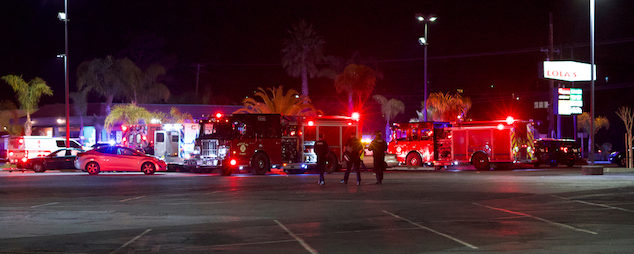Recent News
Amid pandemic, California murder rate shows shocking rise
 Police at a Vallejo crime scene, where three people were shot during an armed robbery. (Photo: Francis Arrostuto, via Shutterstck)
Police at a Vallejo crime scene, where three people were shot during an armed robbery. (Photo: Francis Arrostuto, via Shutterstck)Preliminary numbers from California’s biggest cities suggest that 2020’s stunning 30-percent increase in the statewide murder rate – the largest since 1960 – has continued to rise this year, and crime experts have as many questions as answers.
“We’re seeing a continued trend” in rising murder rates throughout 2021, said Magnus Lofstrom, a policy director and senior fellow at the nonpartisan Public Policy Institute of California. “We’re seeing increases in homicide year over year again.”
Official numbers for 2021, a year with a few weeks remaining, are months away. (Thoroughly analyzed crime data takes time.) But, thanks to the record-keeping reliability of Los Angeles, San Francisco, Oakland and San Diego, researchers have an almost real-time count that shows 2021 is going to be another unsettling year.
Theories abound, but no one knows for sure why, after decades of decline, the murder rate should rise so startlingly.
People who study crime, like the PPIC’s Lofstrom, use those numbers, which are as fresh as last month, to compare current conditions to the past. That’s how they know, for example, that Los Angeles’ reported 331 homicides this year represent a 16 percent increase over the 284 murders in all of 2021. A 16 percent increase would be stunning if it hadn’t followed a year with a jump that’s twice as big.
Farther south, San Diego has so far this year seen another 11 percent rise in killings, having logged 82 homicides by the end of October. In 2021, there were 74. San Francisco’s murder rate rose 7 percent, from 42 last year to 45 this year … so far. Oakland’s preliminary numbers jumped 38 percent, from 81 to 112.
Theories abound, but no one knows for sure why, after decades of decline, the murder rate should rise so startlingly.
“So many things happened all at once,” said Lofstrom, reciting a litany of usual suspects, starting, of course, with the myriad hardships brought on by the pandemic. There’s also a spate of criminal justice reforms, vitriolic politics, civil unrest and a boom in firearm sales. “They’re all possible contributing factors,” said Lofstrom, “but, sadly, it does come down to ‘your guess is as good as mine.’”
“While violent crime rates are still well below their historical highs in the early ‘90s, the increases we’ve seen during this pandemic are unacceptable.” — Rob Bonta
It also comes down to perception. A 30-percent rise in the murder rate is unarguably worrying. But even with that jump – which occurred all over the nation, not just in California – Californians are still less likely to be victims of homicides than in decades past.
“The homicide rate is nowhere near where it was in the 1990s,” Lofstrom said. Back then, about 13 out of every 100,000 Angelenos became the victims of murder each year. But even with the ongoing rise, the current rate stands at about 5.4 per 100,000 – less than half what it was 30 years ago.
That’s cold comfort for California Attorney General Rob Bonta. “While violent crime rates are still well below their historical highs in the early ‘90s, the increases we’ve seen during this pandemic are unacceptable.”
“In California and across the country,” said Bonta, “gun violence in particular continues to be a uniquely American health crisis.”
Gun violence accounted for 90 percent of the year-over-year increase in homicide death from 2019 to 2020. It’s too soon to know how much they’ve contributed to the current ongoing rise, but with firearm sales going up, it’s unlikely the role of guns in murder rates will diminish any time soon.
Brian Marvel is president of the Peace Officers Research Association of California, or PORAC. Like Lofstrom, Marvel said it’s difficult to untangle the many threads weaving the problem together. He cites policy reforms, prison population reductions, pandemic problems, and a political system that he says wants “instant gratification.”
“We’re looking at it as the totality of all the stuff that’s happened over several years,” said Marvel. “There were a lot of changes made very fast, without really tracking the efficacy of those changes.”
“It would be good,” he said, “to see research that takes deeper dives into these changes.”
“It took us a few years to get into this situation,” said Marvel, “and it’s going to take a few years to get out of it.”
—
Ed’s Note: Corrects by subbing “Peace” for “Police” in PORAC title, 13th graf.
Want to see more stories like this? Sign up for The Roundup, the free daily newsletter about California politics from the editors of Capitol Weekly. Stay up to date on the news you need to know.
Sign up below, then look for a confirmation email in your inbox.

Leave a Reply